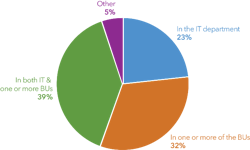The Long & Winding Road to Utilities & Analytics: How Do We Build It?
Over the last decade, utilities have been transforming from electromechanical, operationally focused organizations to digital, customer-centric business.
What emerged rather quickly was a new set of questions that the industry needed to answer if the true promise of analytics was to be realized. Chief among these questions are:
- How should we organize to ensure that we are leveraging analytics to its full potential in our business units?
- What are the technologies that we should use as we build our analytics applications for and with the business units?
SAS Institute recently completed a global survey of utility analytics leaders. The survey tallied responses from 136 utilities from 24 countries. More than half of the responses were from the United States, with Australia, Canada, New Zealand and Denmark rounding out the top five. To help us answer these questions, let’s take a look at some survey results.
One theme that quickly emerged in the utility analytics space was that the skills required to be successful were significantly different from the traditional utility skill sets: What is a data scientist? If data is a strategic asset how do we manage it? What is an R programmer? Answering these questions and others are foundational for a utility as they move forward with analytics investments.
At the heart of these challenges is, “what is the best way to leverage the potential of all of this new data?” Many utilities are developing “analytics centers of excellence" (“ACE”) as a way to both corral analytics expertise and to deploy it across the organization. From our survey, we learned that the larger the utility, the more likely a utility is to have launched an “ACE.” Large utilities, those with one million or more customers, slightly over half of utilities have an ACE already in place, while at the smaller utilities only three out of 10 utilities have launched an ACE.
Once a utility decided to start an ACE, where should it reside in the organization? It turns out that there are numerous answers to this question, none of them necessarily the “wrong” answer.
Figure 1 below shows how survey respondents are organization their ACEs. Note that the dropping the ACE into the IT department is no longer the de facto “right” answer.
Figure 1. Where does the Analytics Center of Excellence reside?
As a utility gets its analytics organization up to speed, questions around what technologies to deploy are often considered in parallel as the organization is being developed. This is often most acute in terms of how or if to leverage the cloud and open source tools and technologies.
The explosion of cloud-based infrastructure and solutions is rapidly changing the IT landscape. Utilities are moving toward the cloud, albeit not as quickly as other industries. This is typically due to data security concerns, not the least of which is maintaining a data security posture that is in line with NERC CIP requirements. However, give these challenges, the survey found that 50% of utilities are likely (either “very” or “somewhat”) to use cloud-based Software-as-a-Solution applications as a part of their analytics approach.
One other rapidly emerging analytics development among utilities is the use of open source tools to execute analytics applications. While open source tools have some limits around scalability, governance, and productivity, their place at the utility analytics table is undisputed. Figure 2 below provides an overview of how some of the more popular open source technologies are likely to be used in the utility industry.
Figure 2. Which of the following open source tools does your utility currently use or plan to use by the end of 2017?
Note that while the use of the R programming language has the highest current use, Hadoop has the highest level of planned use for 2017. As utilities grapple with data storage costs and complexities with their massive smart grid databases watch for Hadoop to become more prevalent.
As the survey results confirm, the age of analytics in utilities is one that requires some new thinking around how to organize and build to realize the full benefits of analytics. Careful consideration around how to build the analytics capabilities and organizations in a way that is consistent with and supportive of the key corporate business will help with these critical decisions being “spot on” or at least “directionally correct.”
In part II of this this series we’ll look at which business areas are being targeted for improvements via analytics.
The Utility Analytics Institute (UAI) is a corporate membership-based organization consisting of more than 110 operating utility companies and leading analytics solution providers. UAI’s mission is to enable its members to realize desired business outcomes using data analytics. SAS is a long-standing member and highly valued UAI member.


